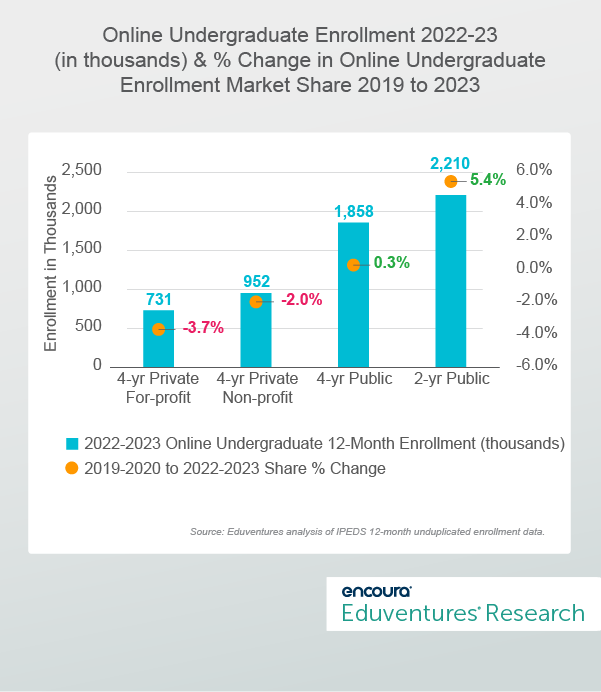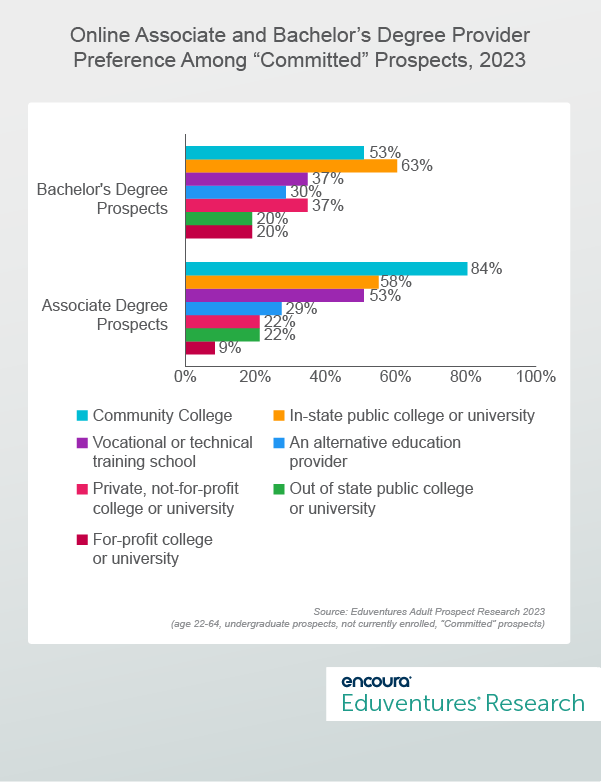In our recent work with four-year, adult-serving universities, we’ve noticed a troubling trend: some schools appear to be losing online undergraduate enrollment to their state’s network of community colleges. Notably, in the cases we’ve analyzed, these students are choosing online programs at these two-year schools.
As two-year public institutions continue to focus on growing online programming, what do online leaders need to know about this segment? And what can they do to mitigate declines in adult online undergraduate programs?
Community Colleges Grow Online Market Share
Overall, online enrollment grew by 35% from 2019-2023, aided in part by the pandemic. But growth was not even across sectors.
Figure 1 shows undergraduate online enrollment in the 2022-23 school year and the percentage change in online market share from 2019 to 2023. It indicates that two-year public institutions had 2.2 million fully online students in 2022-23—the most by far. Public four-year institutions, the next largest sector, had 1.86 million, followed by four-year private non-profit (952,000) and four-year private for-profit institutions (731,000).
Figure 1.
Figure 1 also shows that four-year, private for-profit, and non-profit institutions experienced enrollment share declines (-3.7% and -2%, respectively). Four-year public institutions gained about 500,000 enrollments but the sector remained relatively flat. Two-year public institutions, however, have indeed taken the lion’s share, growing by 5.4% during the period.
In fact, of the nearly 900 public two-year institutions examined here, 91% reported fully online undergraduate enrollment in both the 2019-20 and 2022-23 school years, suggesting that these institutions have a history of delivering online programs and were well-positioned to handle the shift to online learning.
These schools’ fully online programs also saw 76% growth between 2019 and 2022—a net gain of over 4,500 new online programs (both degree and certificates). During that same time, associate degree conferrals from distance programs grew by 17%. Two-year public institutions are embracing the online modality and do not typically have marketing budgets to grow enrollment for online programs but are still thriving.
Notably, of the 2.2 million online undergraduates enrolled at two-year public institutions, not all are working adults. While IPEDS data is lacking in this area, Eduventures estimates that 350,000 to 450,000 are high-school students in online courses for dual enrollment credit.
What else can explain the gains among two-year public institutions?
Online Just Like Before
Eduventures’ annual Adult Prospect Research™ evaluates provider preference among adult prospective students. It shows that adult undergraduate prospects do prefer community colleges over other providers.
According to Figure 2, 84% of associate degree prospects chose community college as the most preferred provider, followed distantly by in-state public colleges or universities (58%). Among bachelor’s degree prospects, an in-state college or university was the top provider preference with 63%, but interestingly, community college was the second most preferred provider (53%).
Figure 2.
These undergraduate provider preferences align with Eduventures’ survey data showing "affordable tuition and fees" as a top priority since these providers are seen as the least expensive.
Looking at this data over time, these have remained the top provider preferences among adult undergraduate prospects between 2019 and 2023. Provider preference aligns with affordability, but what can institutions do that want thriving online undergraduate programs?
The Bottom Line
The community college enrollment surge is likely due to:
- Increased acceptance of online learning combined with increased availability of online programs from these providers
- The affordability of community college programs and perceived greater return-on-investment these programs can provide
Four-year institutions should consider the following steps to diminish the effect these schools have on their adult undergraduate online programs.
- Get the word out earlier. As online undergraduate demographics blur younger, institutions should spread the word to high schoolers about both traditional campus programs AND about online alternatives for those who want to work and might not be ready for or want a campus experience.
- Be transfer ready. Four-year institutions who lose out on these online students initially need to be prepared to serve them once they complete their associate degrees. Expanding transfer credit articulation agreements and smoothing out the transfer credit process is critical.
- Do not try to compete on price. Adult undergraduate prospects are price sensitive. With over half of states implementing some version of free community college, an institution should avoid trying to compete here. Instead, institutions should focus on student support, career services, experiential learning, and other ways to support online students and prepare them for their careers.




